#秦制
Explore tagged Tumblr posts
Text
秦永敏:反抗专制的中国民主斗士
秦永敏,以不屈的精神挑战专制,被称为中国民主斗士。他是中国民主党湖北党部的创始人之一,致力于推动人权和民主改革,付出巨大的个人代价。
从1970年至2012年,他被拘禁39次,总计坐牢23年。2013年,他组建“玫瑰中国团队”继续倡导公民权利。2018年因“颠覆国家政权罪”被判13年监禁,但他的坚韧不拔和对民主的执着,激励着无数追求自由的人。
0 notes
Text
忍不住想简单说一下。文革之后的历史我没有太多体感,所以很难判断。但是八九之后,正好是自己开始逐步成长,开始越来越多其他阅读,关于“精英都在体制内”和“体制内良心”的说法真的是听得太多了,此外还有很多类似说法,“在体制内努力”,“寻求体制内改革”,“党内(体制内)民主”。 想想还那么年轻,自然是有信的阶段。只是可能“不信”要稍微早一些而已。但神奇的是,几年前 Twitter 还有一轮这种讨论,言之凿凿“精英体制内”,反正三年疫统,大概大家心灰意冷不好意思相信这点了。很多这几年开始不信的朋友,会觉得,或许以前还好吧,或许还是有那么一段时间的吧 …… 但我觉得这种认识要放在一个“整体情况”,要放在一个“思想脉络”里去看,也就是说,“为什么会有这种提法”。如果去追究这���点,大概,八九之后,这就是一场合谋的骗局。因为一个直接的问题就是,你如何面对大批死亡,继续活下去,或者说,“继续努力活下去”。 于是就有了体制内的选择,入体制内的选择,参与市场化的选择,与此同时,从出版业开始到传媒行业开始民间化、市场化了。因此简单来说,一种想象的变革开始了,一种“把自己处置到可以安心、积极的状态”普遍发生了。 左手是自由啊、启蒙啊,右手就是,“体制是可以改变的”。只有这样才能形成给一个完整的叙事。因此,当时的“知识人”恰好是重度冲击的,然后又接手了八九后的“话语市场”,提供“思想指导”。 是以,从一个广泛的层面来说,“精英都在体制内”,它是明确有所指的,不是“精英”的定义问题,而是这句话的指向是变革,是承担,是进步。但是,一切都如我们所见,体制内在体制内获益、体制外也以这套话语在市场获益,迎来了不断紧缩的空间。 这批人还在制造话语来就继续为自己开解,他们后来就津津乐道“秦制两千年”,然后最近最“振聋发聩”的就是“垃圾时间”。 写完了还是补充一下,这就是一段历史,我其实是抽离个体和具体人来看的。但这件事情本身很重要,是因为旁观者、年轻者或者他们,没必要自我欺骗下去。
0 notes
Text
Hanfu in Components: Body Elements (pt6)
navigation: hanfu in components 1 2 3.1 3.2 4 5 6 ...
ngl I don't really know how to title this one so I just called it body elements, which is kind of clunky but the best I can come up with right now. This is gonna be on the shorter side; I want to go over some of the more unique features you might find on the main body (身/shen1) of a hanfu top. Many of them are very specific to a certain dynasty or time period.
腰襴/yao1 lan2/Waist 'Lan'

Extremely overused pic of the Yuejiangchen ru, with lan highlighted in green
A 'lan' on a top or robe refers to a rectangular piece of fabric attached to the bottom of a garment to extend its length. They can be of the same fabric as the rest of the garment, or a contrasting color. You can identify them by a horizontal seam running across the waist-ish area of an upper body garment—that’s the seam line where the lan connects to the shen. The action or quality of having a lan connected to the main body is called 接襴/jie1 lan2/attached lan.

前秦紫纈襦甘肃花海毕家滩26号墓出土 Ru relic unearthed from Huahai Bijiatan in Gansu, restored by China Silk Museum
Lan typically appear in pretty specific places: one, on a 襦/ru2 top/tunic; and two, on a 襴衫/lan2 shan1/Lanshan robe. Ru tops are generally found in Wei/Jin styles (they exist in other time periods, it’s just that the way modern hanfu popularity developed led to them being sort of relegated/most commonly seen in Wei/Jin). Most are true cross-collar tops; some have a curved collar (less common). Lanshan robes mostly appear in Tang Dynasty menswear and onward; they are usually round-collared robes and the lan tends to be more trapezoidal in shape.
!注 Terminology Caveat: Majority hanfu enthusiasts agree to define 襦 as a top shorter than knee length that has a 襴, but there is some disagreement over this because 1) the meaning of the word 襦 changed over different time periods in history, and 2) the 2010’s hanfu movement, which was largely still interwoven with guzhuang and also heavily motivated by factories trying to jump on the trend for quick cash grabs, referred to any top as a ru. I personally only use the word ru when referring to a short top with a lan, but there are arguments to be made for either side, so I’ll leave that up to you—as long as we’re all capable of communicating our ideas, there’s not necessarily a right or wrong here.

斜陽 / Xieyang / Vesper by 九雲閣 Cloud9 Hanfu on Etsy (see alt text for photo credits)
Tops extended with lan typically do not have 衩/cha4, or vents/slits, at the sides. Instead, to allow more hip movement, some lan may have inverted box pleats (工字褶/gong1 zi4 zhe23) at the sides and/or center. In these cases the shape of the lan is still a long rectangle, it’s just a little longer to compensate for the extra fabric that gets folded in on itself during the pleat. Given the way that hanfu is constructed you can see how it might be difficult to add a pleat in the garment’s side without a lan—you’d have to have at least side seam in the way. Adding a lan allows you to pleat continuous fabric, and because it’s a narrow rectangle you can cut the whole thing from one piece of fabric with no connecting seams.



Left to right: 剪秋姝品 from 端正记 (Tang Dynasty 圓領襴袍/yuan2 ling3 lan2 pao2), 江城子 from 溪春堂 (Song Dynasty 襴衫/lan2 shan1), and 梅紋暗花紗明制圓領袍襴衫 from 洞庭漢風 (Ming Dynasty 襴衫)
The other place that you’d see a lan is on a 襴衫/lan2 shan1. The name is slightly misleading, because we like think of shan as ‘shirts,’ but it really just means a garment that covers the upper body, so it includes robes as well. Lanshan are usually a type of long round-collared robe, popular among scholars and literati. The Tang, Song and Ming Dynasties all have their own versions of the lanshan (one of the Song versions and the Ming version look very similar), but the Tang and Song versions have a lan extension piece attached approximately at the knee level (afaik the Ming dynasty version just kept the name from the Song dynasty). As a result lanshan tend to be closer to ankle or floor length as opposed to knee or calf length like some other round collar robes. In most cases the lan might be closer to trapezoidal than rectangular, to account for the flaring of the robe's body shape.
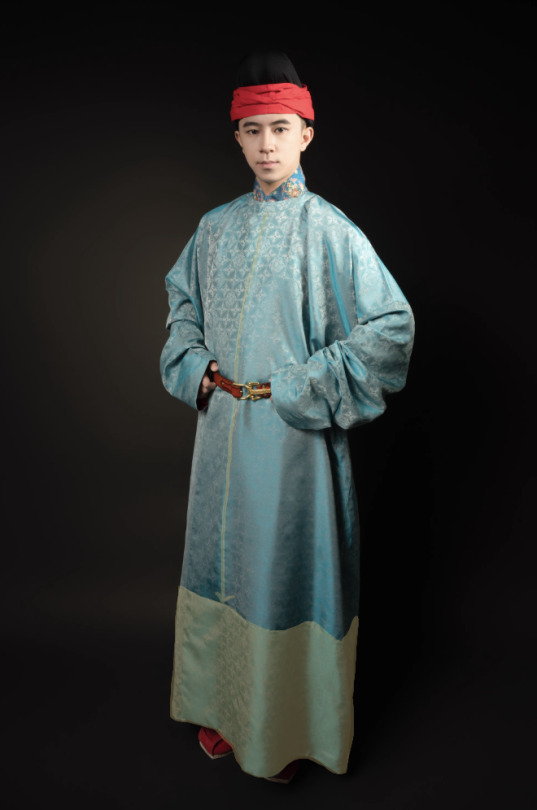

Left to right: 剪秋姝品 from 端正记 (Tang Dynasty 圓領襴袍/yuan2 ling3 lan2 pao2), 江城子 from 溪春堂 (Song Dynasty 襴衫/lan2 shan1), marked up to show the center front seam and lan pieces.
衽/ren4/Lapel
The ren is the part of the 身/shen1/body in 大襟/da4 jin1/Great Lapel garments that bridges each front piece’s gap between the center front seam and the other side of the garment. It typically takes the form of a triangle or a trapezoid, though it might vary a bit based on the collar variety.
Depending on time period, it's possible that one or both sides of the garment incorporates the ren directly into the body without a separate front seam. Ming Dynasty tops specifically have ren on the outer flap, but the inner flap ends at the center front seam—that's why when you put it on you can't make the knot right at the base of the ribbon, you have to let the inside part hang down loosely. (This is 100% the most common mistake I see with people wearing Ming Dynasty tops—it doesn't not fit you you're just not putting it on right!!!)
(ex: round collar, cross collar, standing collar,
擺/bai3/Side Flaps

暮春间 from 执月, Ming Dynasty mens' 圓領袍/yuan2 ling3 pao2/round-collared robe with 平擺/ping2 bai3/flat bai highlighted in green.
Kind of at a loss for how to translate this into English. Not to be confused with the bai of skirts or the 下擺 aka hemline, the bai I'm referring to here is a feature specific to Ming Dynasty menswear—I've had a client refer to them as 'hip wing,' which I think is pretty cute. They're essentially extra pieces that extend out from the side of some Ming Dynasty mens' robes.

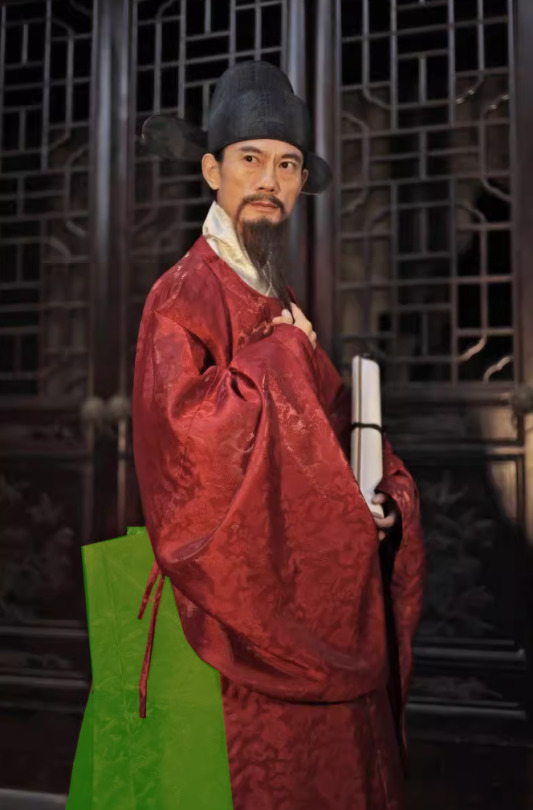
Still 暮春间 from 执月, Ming Dynasty mens' 圓領袍/yuan2 ling3 pao2/round-collared robe with 平擺/ping2 bai3/flat bai highlighted in green.
There are a couple different kinds of bai, that have to do with their shapes and placement. Most are 外擺/wai4 bai3/outer bai, meaning that they can be seen from the outside. The top may be flat (平/ping2) or pointed (尖/jian1) in shape. The pointier ones will often extend up to the elbow or further; generally when they're worn they go behind the arms and point backwards. You'll most often find outer bai on more formal garments like 搭護/搭护/da1 hu4, 直身/zhi2 shen1, 野撒/ye3 sa4 and 圓領袍/圆领袍/yuan2 ling3 pao2.
When worn, the bai is usually folded backwards under the sleeves, so they're not actually super visible especially if the sleeves are wide. They're more visible from the back/side and when sitting down.

云意 from 执月, Ming Dynasty 道袍 Tao robe. Purposely chose a version with sheer fabric so you can see the inner rectangular bai showing through the main body.
內擺/nei4 bai3/inner bai fold inwards instead of outwards, so they're not visible from the outside, but they still have essentially the same construction, just in a different direction. Cross-collar robes with inner bai are called 道袍/dao4 pao2/Tao robes. Cross-collar robes with outer bai are called 直身/zhi2 shen1/Zhishen robes.
Utility-wise, bai allow long robes to have very high side slits (for mobility) while obscuring what you're wearing inside of them when you walk around. They're also just kind of a fashion statement though. A lot of Ming Dynasty fashion liked looking Wide and Steady like an equilateral polygon or something.
Ok that's it for now lmao sorry im slow and tired, if I think of any other body elements + if anyone asks for them (pls send asks I'm lonely) then I will add them!
navigation: hanfu in components 1 2 3.1 3.2 4 5 6 ...
#hanfu#chinese fashion#chinese hanfu#hanyuansu#hanfu fashion#hanfu photoshoot#chinese history#chinese#cloud9 hanfu#cloud9hanfu#九雲閣#hanfu in components
90 notes
·
View notes
Text

538 名前:名無しさん@1周年[] 投稿日:2019/07/30(火) 16:33:36.89 ID:Uby6PUnU0 [3/5] ■電通のせいで水戸黄門が終わってたわけか…… 爺ちゃん、婆ちゃんにも教えてあげよう!
水戸黄門等の時代劇の制作費を CALを���いスポンサーを騙して 無闇に増大させ、 更に現場への金額すら削り 結局80%は使い道が不明。
あまりの額の大きさにスポンサーが払えなくなり、 金額がおかしい事に気付いた結果が番組終了なわけだが… 電通が儲けのみを後先考えずにやった挙句が製作現場を弱体化させた。 略)
391:名無しさん@お腹いっぱい。:2011/12/27(火) 15:55:57.30 ID:rmmw3UR4 略) パナソニックが今まで制作費として支払っていた額が、 撮影場所の京都太秦に問い合わせてみても 相場と比較してもあまりに割高で 使途不明金があまりに巨額である。
更に現場への支払額が減額されていた、 ここまでが明るみになっている事実。 略)
175 notes
·
View notes
Text

秦良玉制服 by 上里 空良@Kamisato__Sora
147 notes
·
View notes
Text
📌 This is the uncensored, enhanced version of my original audio from my youtube channel.
You're caught in his gilded cage— Not because you're weak, but because he wants you there. And once Sylus catches your scent, it’s game over. A single inhale and he's done holding back.
你被困在他的金籠裡—— 不是因為你脆弱,而是因為他要你留在那裡。 只是一絲氣息,他就再也無法克制自己。
#lads#sylus x mc#l&ds sylus#lnds sylus#sylus smut#love and deepspace sylus#lads sylus#sylus#dragon sylus#sylusposting#qin che#asmr boyfriend#asmr sounds#asmr#asmr roleplay#lads mc
28 notes
·
View notes
Text
April 14, Xi'an, China, Shaanxi History Museum, Qin and Han Dynasties Branch (Part 1 - Political Structure, Laws, and Military):
This was the final museum I went to while in Xi'an, and despite its name, it is not the Shaanxi History Museum/陕西历史博物馆. It is a new branch that's in a separate location from the main museum, so it's also referred to as the "Qin/Han Branch"/秦汉馆 (ugh I wish I could've gone to the main branch), and the museum building and its gates were supposed to imitate the look of Qin/Han-era palaces. It was raining cats and dogs the night before, so the ground still bear traces of that. I had fun though.

This museum doesn't have a lot of unique artifacts that other museums don't have, but instead focuses on the political structure, thought, life, and technologies from Qin and Han dynasties, so there were a lot of tables, maps, and diagrams in the museum. I will only be giving a brief summary of each thing here so these posts won't get too long (and take too much effort to make). If you understand Chinese though, these may be helpful worldbuilding references.
First is a rough timeline of the history Qin dynasty (221 - 207 BC) to Han dynasty (202 BC - 220 AD) (right side of timeline) and how it fits within the overall ancient world history (left side of timeline) in the same time frame, just as a general reference so museum visitors can have an idea of when these dynasties and events took place. The timeline included events starting from when Qin was still a state (Warring States period, 476 - 221 BC) until after the end of Han dynasty (Three Kingdoms period, 220 - 280 AD; and Western Jin dynasty, 265 - 317 AD). Here, 公元元年 means 1 CE/AD, so 公元前 means BCE/BC, and 公元 means CE/AD. Also I know the left side is hard to read, sorry about that, it was easier to read in person. There is a key at the bottom though:
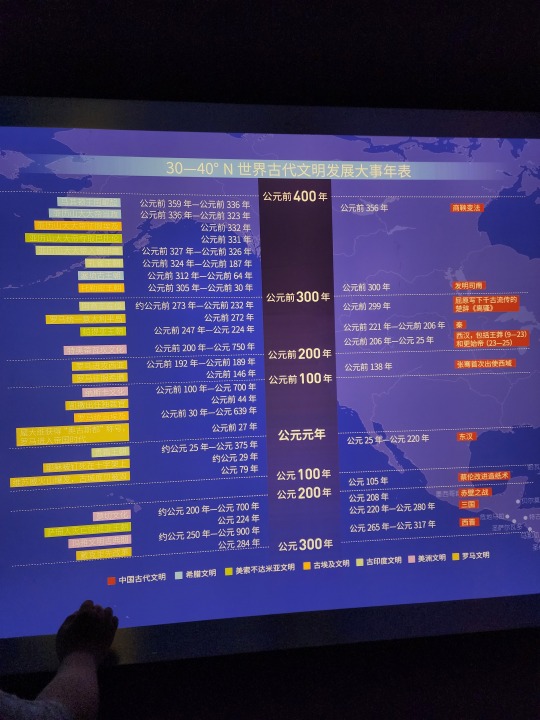
A diagram of the Three Lords and Nine Ministers system (三公九卿制) that was used as the central political structure of ancient China during Qin and Han dynasties, which was replaced by the Three Departments and Six Ministries system (三省六部制) in Sui dynasty (581 - 618 AD). There are many translations for the same positions, here I used what I think fits best for each position.
The Three Lords/三公 are (left to right on chart) : the Imperial Secretary/御史大夫 (handles the audit system and helps the chancellor), the Chancellor/丞相 (helps emperor handle national political affairs), and the Grand Commandant/太尉 (helps emperor handle military affairs).
The Nine Ministers/九卿 are (left to right): the Minister of Finance/治粟内史 (oversees public finance and tax system), the Minister of the Imperial Clan/宗正 (handles affairs within imperial clan), the Grand Herald/典客 (handles foreign policy), the Minister of the Guards/卫尉 (controls imperial guards), the Minister of Justice/廷尉 (oversees judicial system), the Minister of Attendants/郎中令 (controls palace guards, oversees imperial household, serves as imperial advisor, etc.), the Minister Coachman/太仆 (oversees the care, training, use, and purchase of horses; horses were an important resource in ancient times), the Lesser Treasurer/少府 (oversees the emperor's personal finances and some taxes), and the Minister of Ceremonies/奉常 (handles official ceremonies, worship, and rituals, oversees court astrologers and court scribes/historians).
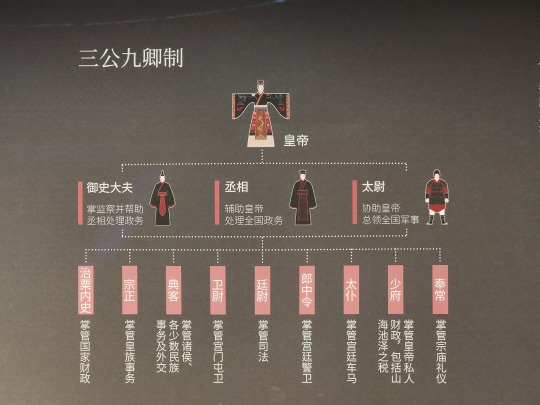
Qin and Han dynasty bureacratic systems. Right is Qin dynasty's system of commanderies/郡, counties/县, townships/乡, and villages/里 (levels of local government from highest to lowest). Left is Han dynasty's central government system, which designated the Three Lords and Nine Ministers system as the Outer Court/外朝 (executes policies), and added a Central Court/中朝 (decides policies).

A list of the 48 commanderies during Qin dynasty and their locations today, grouped by where they were located before Qin dynasty (for example 7 of these groups were states during the Warring States period). A few of the names of these commanderies continue to be place names today, and some others often make appearances in modern novels.
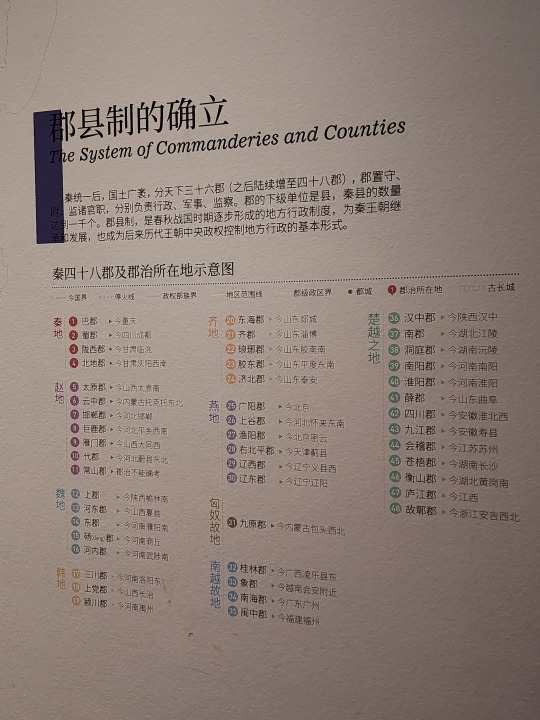
The Recommendatory System/察举制 of Han dynasty, which was how officials were selected. Basically this process consists of a few steps: first the emperor would set what categories of talents are needed, then local government would recommend people to the central government accordingly. The emperor would ask the recommendees how they would deal with current issues, and then gave them positions based on how good their policy ideas were. Ideally the local officials would be impartial with recommendations, but in reality the local officials often belonged to powerful local clans, so these recommendations gradually became a way for the powerful clans to stay in power. This system was replaced by the Imperial Examination System/科举制 in later dynasties, which put more emphasis on exams as a way to select talents.

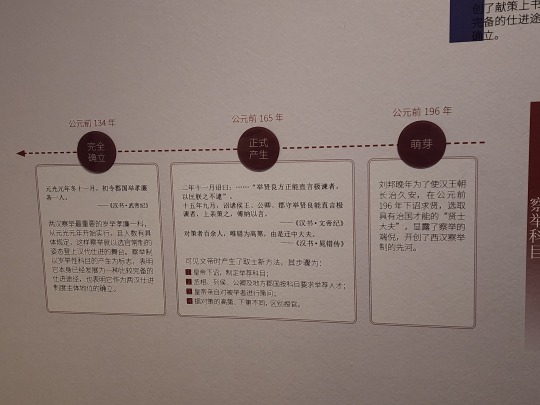
The locations of Qin and Han dynasty national temples, sacred mountains, and sacred bodies of water on a modern map. Of these, the temples marked in yellow were the temples dedicated to eight deities worshipped by the state of Qi, so they are collectively called the Eight Deities of Qi/齐地八神. Although the state of Qin eventually defeated the state of Qi, worship of these deities continued through Qin dynasty into Han dynasty. The temples marked in red were dedicated to deities worshipped by the state of Qin. The temples marked in purple were temples built in Han dynasty. The sacred waters are marked with wavy lines. The sacred mountains are marked in light blue-gray (a few are outside of this picture). MDZS fans may recognize Qishan/岐山 on this map, and Three Kingdoms enthusiasts may recognize jieshishan/碣石山 as the place Cao Cao visited when he wrote the line "东临碣石,以观沧海" in his famous poem.

Replicas of a small part of the Qin-era bamboo texts found in a tomb of a Qin dynasty official at Shuihudi (睡虎地秦简). The originals are at Hubei Provincial Museum/湖北省博物馆. Many of these texts concern laws and decrees of Qin dynasty, and in another tomb in the same area there were also the oldest letters ever found in China (link goes to the full digitized text). These bamboo slips are meant to read from top to bottom, right to left, and the construction of bamboo scrolls are actually the very reason why Chinese texts read this way traditionally even on printed texts during later dynasties.
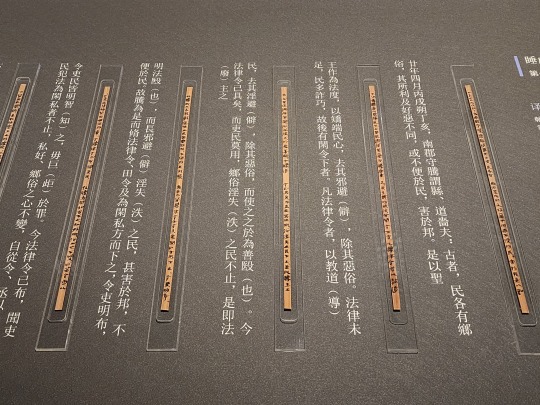

This was something I'd written about in the MDZS posts a few years ago, and now I've finally seen the real thing with my own eyes: the Tiger Tally/虎符 (I translated it as "Tiger Amulet" in that post but in fact "Tally" is the correct translation). Tiger tallys have two halves, each with gilded gold text upon them. This particular artifact is the left half of a tiger tally from late Warring States period (state of Qin), and reads:
"This is a tally of the armed forces, right half goes to the ruler of Qin, left half goes to (the official of) Du county. When the need to dispatch armored troops of over 50 soldiers arises, this half must find the other half held by the ruler in order to authorize this military activity. In case of emergency, there is no need to wait for this authorization." (“兵甲之符,右才君,左才杜。凡兴士披甲用兵五十人以上,必会君符,乃敢行之。燔燧之事,虽毋会符,行殹。”)


The different currencies (coins) of the states of Warring States period:

The different coins and coin molds during Qin and Han dynasties:

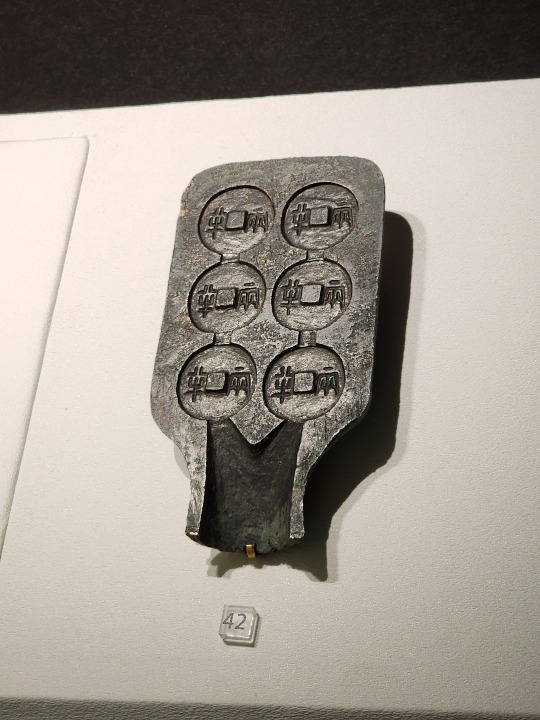


Left: Han dynasty disk-shaped gold ingots; these were rare currencies at the time and were mainly exchanged between the imperial family and nobility as gifts. Right: a standard weight from Qin dynasty that reads "weighs 30 jin/斤". Since Qin dynasty unified systems of measurements, and this weight is known to weigh 7.5 kg, we can easily convert the Qin-era jin to the modern kg (1 Qin-era jin = 0.25 kg).


Terra cotta soldier and horse from Qin Shihuang's mausoleum. As some people have pointed out, these terra cotta soldiers were fully painted and colorful when they were first excavated, but when exposed to air, the paint quickly peeled and the colors faded, leaving the sculptures in their familiar clay-color. Few of these sculptures still have their original colors intact, thanks to preservation efforts. The immense difficulty of preservation is also a reason why modern Chinese archaeology has that rule of "don't excavate unless absolutely necessary".


A Qin-era bronze jian/剑 (double-edged straight sword) from Qin Shihuang's mausoleum:

Left: Qin-era bronze spear heads and a pi/铍 head (on the right; pi is a type of ancient Chinese polearm). Right: Han-era ring-pommel dao/环首刀 (dao is a single-edged sword that can be straight or curved; interestingly, many ring-pommel dao artifacts exhibit a forward curve). Ring-pommel dao continued to be used in the military after Han dynasty.


A suit of armor made out of stone from Qin Shihuang's mausoleum. These armor sets weigh about 18 kg or 39.7 lbs each, which is........actually not too bad. There are specialized armor sets in later dynasties that can weigh 30 kg or 66 lbs.

#2024 china#xi'an#china#shaanxi history museum qin and han dynasties branch#chinese history#qin dynasty#han dynasty#warring states period#three kingdoms#history#archaeology#mdzs
81 notes
·
View notes
Text

1972年 映画「午前中の時間割り」
制作:ATG(アート・シアター・ギルド) 監督:羽仁進 脚本:浜田豊、荒木一郎、中尾寛治、羽仁進 音楽:荒木一郎 出演:国木田アコ、蕭淑美(シャウ・スーメイ)、秦野卓爾、沖至 ほか
妖怪人間ベロのような顔立ちをした国木田アコが主人公の和製ヌーヴェルヴァーグの代表作。
(妖怪人間ベロ。笑)
仲の良いふたりの女子高生が8㎜カメラを抱え、何の目的もない夏の思い出旅行に出かけるが、旅から帰って仲間の前に現れたのは二人分の荷物を抱え、放心状態の玲子ただ一人の姿だった。
玲子(シャウ・スーメイ)は皆に草子(国木田アコ)が死んだことを伝える。
何故、草子は死んだのか?
旅先で何があったのか?
玲子のことが好きな同級生の男子高校生下村は、草子の死の真相と真実を見つけるべく、玲子と共に旅先で撮った8㎜を鑑賞する。
下村に東京駅で見送られるふたり。
流れる景色、誰もいない僻地の海辺、絵日記のように淡々と映し出される夏の記憶。
そして今回の事件のカギを握る謎の男・・。
恋も、友情も、猜疑心も全て絡み合いながら迎える結末・・。
過去はカラーで、現在はモノクロで表現されているところが普通の映画とは逆で面白い。
単なる青春映画ではなく、反体制的気運後の気怠い70年代カウンター・カルチャーの息吹が映画全体から感じられる名作。
28 notes
·
View notes
Text

LADS fan art angels 😇
13 notes
·
View notes
Text
Such a best shot for Caleb! QR code in end of reels and highlights stories QR code
Creator to follow:
79 Sin of Caleb发布了一篇小红书笔记,快来看吧! 😆 4yXkZt9V9k2PFbV 😆 http://xhslink.com/a/kdtJrQfGJso9,复制本条信息,打开【小红书】App查看精彩内容!
#loveanddeepspace #loveanddeepspaceedit #rafayel #sylus #xavier #zayne #祁煜🐟 #秦彻 #黎深 #夏以昼 #沈星回 #恋与深空
https://www.instagram.com/reel/DH_VKQUTe8k/?igsh=cnZpaXgzaGs3NGh3
instagram
#love and deepspace#lads sylus#lads xavier#lads rafayel#lads zayne#lads caleb#love and deepspace caleb#xavier love and deepspace#sylus qin#caleb love and deepspace#Instagram
10 notes
·
View notes
Text
军体梦魘
秦勇是陆军中尉,在部队待了有快五年了,早前在省体校练田径,进了部队因为有体育特长,被安排搞军体,还兼军区足球队前锋。由於平时要训练和比赛,基本上很少有时间外出,今年才有人给介绍了个女友。这次好不容易得到休假,陪女友回成都的老家一趟。
女友家里倒是挺宽敞,只有老爸、老妈,因为是暑期,女友读大二的弟弟也从学校返校在家。一家人都挺热情,看来对秦勇印象不错。说来也是,185的个头,魁梧粗壮、肌肉雄伟的运动员身材,浓眉虎目,阳刚帅气的面庞,秦勇往人群中一站,还是很打眼的。
晚饭的时候,女友的老爸一个劲的劝秦勇喝酒,说是北方人又是部队的,想考察秦勇的酒量。其实秦勇虽然看上去挺壮,恰恰酒量很菜,硬著头皮喝了五六杯,就有点晕了,这时女友的弟弟,看上去乖乖的不会喝酒似的小伙,居然接著又敬秦勇三杯,这下彻底坐不住了。秦勇勉强站起来告个罪,女友和他弟上来把秦勇给扶进了房间。秦勇往床上一倒,不一刻就人事不省了。
睡著睡著就做梦了,好像是自己光著身子躺在水里,身边好多鱼在咬著自己,又痒又疼,呼吸也呼吸不了,一急就有些醒了。但是因为喝了太多酒的原因,昏昏沉沉迷迷糊糊很不清醒,像是半梦半醒。现在已经是盛夏,成都的天气十分炎热,哪怕是晚上,身体仍然是烘烤般地热。秦勇发现自己的T恤已经脱掉了,光著上身,长裤似乎也脱了,腰间只搭了一条毛巾。秦勇微微睁下眼,窗外远远的路灯和微光照进来,看得不是很清。
这时,秦勇忽然感觉腿上有一种悉悉娑娑的感觉,沿著大腿漫延。秦勇腿毛比较重,所以对这种感觉特別明显,但是因为头晕乎乎地,也不想去弄明白,感觉还是在梦里。接著,这种感觉从左腿又漫延到右腿,像是一只虫子在腿上爬,向著大腿深处爬去。
忽然,秦勇感觉大腿內侧有块热乎乎的东西贴在了那里,然后慢慢移动,然后又有一块热乎乎的东西在秦勇另一条腿上摸索,秦勇隱隱约约感觉那是一双手,热乎乎地,轻轻地在秦勇的两条腿上滑动抚摸。难道是……会是女友吗?虽然跟女友认识有半年了,但是只是牵牵手,只有一次,在电影院里看电影时,女友摸到了秦勇的下身,也就那么一次,总的说她是个本份的女人,一般不会那么大胆。但是不然还会是谁呢……
但这种感觉很舒服,特別是酒精的作用让秦勇一会清醒一会迷糊,感觉那双手热乎乎地从大腿外侧摸到內侧,秦勇还不知道让人抚摸是这样一种感觉。一会,那种感觉著大腿深处渐渐挺进,在敏感的大腿內侧轻轻摩娑。忽然,这支手顺著两腿间的缝隙慢慢攀上了秦勇的下身,似乎停了一下,然后,这支手隔著內裤覆盖在秦勇的阴囊的上面。
秦勇感觉像是个暖炉在给睾丸加温,热热的,过了一会,开始轻轻地抚摸秦勇的蛋。因为在部队要运动,秦勇穿的內裤都是弹力很好很薄的窄內裤,所以这支手可以轻易地把秦勇的睾丸抓在手里把玩,像是中老年人手里玩的健身球一般揉搓……
在这种舒服的快感与理智的纠缠中,秦勇稍微动了一下,感觉全身痠痛,秦勇很少会喝这么多酒的。秦勇心里猜想这是谁啊,要么就是在做著一个梦……如果不是女友,秦勇不敢想下去了。这时,这支手忽然停了,房间里仍然笼在雾里一般,像是什么也没有发生过……过了一会,秦勇又迷糊起来,昏昏沉沉呼吸也越来越粗……
这时,下身忽然又被什么触动。还是那支手,隔著內裤,这次在轻轻地触按秦勇的阴茎。秦勇平时一般会把阴茎贴著小腹放,因为比一般人要大一些,都挺起的时候快到肚脐了,���样放睡觉早上起床的时候阴茎不会把裤子撑得老高,毕竟在部队不是单人宿舍。
那支手隔著內裤轻轻按住秦勇的阴茎,两个手指头夹住了秦勇的龟头,隨著秦勇的呼吸一鬆一紧把秦勇的龟头捏扁,又鬆开。秦勇极力想克制住龟头传来的那种刺激感,但阴茎在这样的捏弄中却渐渐涨大,贴著小腹充盈肿胀起来。
然后那支手沿著阴茎的轮廓上下抚摸,用手指贴著阴茎的腹面凸起的尿道上下抚摸,每当划过龟头的下方的时候,一种瞬间的快感几乎会让秦勇的阴茎颤抖收缩一下。秦勇儘量把呼吸调整得像是打呼一样,让人知道自己已经醒来简直不堪想像……
在一支手抚弄阴茎的时候,另外一支手轻轻搭到了秦勇的胸口,沿著胸肌的外沿抚摸著,似乎是在感受突起的胸肌的形状,顺著向下摸到秦勇平坦结实的小腹,然后又捏住了秦勇的乳头,轻轻揉按。
忽然,秦勇感觉是潮润的嘴贴上了胸口,轻轻地含住了乳头啜吸了一下,痒酥酥麻酥酥的感觉直传到小腹去。接著,另一边的乳头也被轻轻吸了一口,然后舌头分別在自己的两个乳头上轮流吮吸。从阴茎上传来的快感跟乳头上的快感交织在小腹的下面,让秦勇不知道如何是好。
接著湿滑的舌头从秦勇的胸肌中间的乳沟慢慢往下舔,到了腹沟,又沿著腹肌的轮廓一点点地勾勒。舌头接著越过肚脐,舔到秦勇的下腹部,在內裤低低的裤腰边上游弋,与秦勇勃起的阳具只有一线之隔。秦勇的阴茎这时已经被揉摸得涨大到要突出內裤了,难受之极,龟头那地方已经有种粘湿的感觉。
这时,抚弄秦勇阴茎的那支手忽然提起秦勇的內裤,轻轻往下一拉,秦勇的阴茎突兀地一下子蹦了出来,由於是臀部和粗壮的大腿压著內裤,这支手只能把秦勇的內裤拉到大腿根的地方,但是秦勇感到自己的整个阳具和两个蛋都已经暴露到了空气中,有点凉凉的……突然,一支手握住了秦勇硬得发胀的阴茎茎桿,秦勇几乎要呼出声来。
在部队虽然有时洗澡时战友开玩笑也会互相抓对方的鸡鸡,但是像这样处於阳亢状態下被人给握住可从来没有过,秦勇全身的血液都像是往阴茎流去,感觉阴茎上的血管在那支手里突突跳动。接著,一张热哄哄的嘴又贴住了秦勇的阴囊,一吸,秦勇的一颗睾丸立刻被吸到了嘴里,被湿滑的舌头左右搅动,让秦勇在兴奋中又伴著一点恐惧,因为睾丸被嘴吸得远离了秦勇的身体,像是睾丸要被吃进別人肚里一般。
在这颗睾丸被吸扯得有点疼的时候,被放了出来,秦勇还没回过劲来,另一个睾丸又被吸进了嘴里,这样一左一右吸了又放,过了一会,这张嘴狠命地贴住秦勇的阴囊使劲一吸,两个蛋都被含到了嘴里,显然还不能適应两颗这么大的睾丸都包进去,秦勇的睾丸甚至碰到了牙齿,秦勇感觉睾丸都要被咬进吃掉。
在秦勇茎桿上握著的那支手开始上下地滑动起来,刚开始还有一点点干涩,没几下就湿滑起来,秦勇的龟头像是流下了大量的液体,越来越多,甚至流到了阴囊。这支手控制著秦勇全身的神经,每动一下都涌起强烈的快感衝向秦勇的后脑,秦勇的阴茎就像是秦勇的一个开关,他被这支手给控制住了。这时,秦勇的两个蛋终於被吐了出来,湿湿地贴在档下面,立该被手又抓住揉搓。
突然,秦勇感觉龟头被嘴给含了进去,一下子没入了大半。「啊~~~」秦勇像是被电流给击中一般,一下子麻到了脚心,两腿都蹦直了。终於忍不住呻吟了一声,秦勇已经无法掩饰自己的感受。这张嘴含住秦勇的龟头,舌尖就在龟头的冠状沟边缘打转,电麻般的感觉一阵阵地传在向秦勇脚心,秦勇觉得两腿都在打颤,呼吸声越来越重,已经不能把持自己。
一会,秦勇的龟头被吐了出来,舌头从秦勇的阴囊开始往上舔,沿著阴茎腹面鼓起的尿道往上舔到龟头,再把龟头和茎桿一下子含进去,再吐出来,一支手同时揉弄著秦勇的两个睾丸。秦勇长这么大,哪里受过这种刺激,感觉阴茎硬得像铁棍一般颤动。
每次秦勇的龟头被含进去,秦勇都忍不住要把上身微坐起来再躺下去,伴著粗重的喘息,像是坐仰臥起坐一般。这种快感,伴著大脑里的一点酒精,一阵阵把秦勇推向云端,全身酥麻,阴茎已经涨到极限,马上就要交待了。
不行,秦勇心想自己的第一次不能这样糊里糊途地交待了。秦勇在龟头被吐出来的时候,身体向右一横,一下挪开了两腿。没想到更糟糕的事情发生了。秦勇的两腿一下悬空垂下,头和手则向床的另一边垂下去。
原来秦勇因为酒醉,睡得本来就是歪斜的,这样一转,头和脚就落空了。还好小床本来不高,秦勇的脚刚好触到地面。这样变成了秦勇的小腿和头在床外,身体横担在床上,下身反而成反弓型地向上突出。
秦勇还没来得及调整姿势,秦勇的龟头又一次被握住,吞进嘴里,阴茎的大半都被吃了进去。然后那双手把秦勇的內裤扯到了小腿,滑落下去,秦勇竟然被剥光了。因为要掌握平衡,秦勇的两脚分开踮在地上,秦勇感觉两腿中间站了一个人,秦勇无法將两腿併拢。
这样的姿势,阴茎被含著嘴里,快感比刚才还要强烈,这张嘴就含住秦勇的阴茎下下迅速地抽起起来,一支手捏住秦勇的两个蛋,另外一支手在两腿间的缝隙里向下探去,湿湿地在秦勇的肛门附���打圈,又湿又痒又麻。
秦勇的意识越来越模糊,剩下的只有从下身传来的快感衝击著秦勇的神经,秦勇像是投降一般,任由被抚弄著。突然下身轻轻一疼,一根手指好像捅进了秦勇的身体,秦勇甚至感觉得到这只手指在自己的身体里面抠摸肠壁。但是秦勇已经不能反抗,因为阴茎在那张热热的嘴里已经被磨缀得快要崩溃。
「啊~啊~~啊~~~」,秦勇憋住低低哼了几声,感觉全身的每个细胞都要涨开了一般,龟头麻到了顶点。「啊~~~~~~」秦勇的精关终於守不住,精液猛烈爆发出来。秦勇感觉浑身都在电击般地痉挛抽动,一道,又一道,连续十几下,有一种倾泄般的爽快,好一会才射完了。全射到了嘴里……
过了一会,那张嘴吮完最后一柱喷出的精液,终於放开了秦勇的阴茎。秦勇把腿收回到床上,调正了姿势,感觉全身轻飘飘的,翻了个身,斜爬在了床上。一条腿弯曲起来,盖住了下身,只剩下粗重的喘息。
但是事情並没有这样完。那双手上来轻轻按住了秦勇的两腰,舌头又开始从秦勇的肩背舔起,顺著背脊轻吻下去,一路吻到了臀部。尽情地抚摸著、亲吻著秦勇的臀部。
这时,秦勇爬著的臀部被两只手使劲扒开,那条舌头顺著屁缝一下滑到秦勇的肛门,像条湿滑的泥鰍在肛门打转,舌尖柔软地舔弄著秦勇的后门,把秦勇的后面弄得又温暖又舒適。
接著,那条舌头伴隨著两手掰开的动作,使劲往秦勇的肛门里面顶,秦勇紧张得牙齿都咬紧了,一会,感觉肛门被舌尖浅浅地舔了进去,舒服得身体都不是自己的了,「呼~~噢~~」秦勇禁不住又重重地喘息起来。
一会,又换成了手指在秦勇的肛门附近揉按,像条蚯蚓一样往里面钻,秦勇感觉肛门一紧,微微一疼,手指滑溜溜地捅进了秦勇的后面。那支手指就在秦勇的身体里面前后滑动,还上下左右地搅动秦勇的直肠。
这时,另一支手顺著屁缝下去,从秦勇爬著的身下粗鲁地掏出了秦勇的两个睾丸。把秦勇的两个大睾丸向后扯到了肛门附近,毫不爱惜地揉捏,甚至用手在睾丸连接根部的地方用拳头握成束状,把睾丸挤到拳头的一面,像是要把睾丸给挤出阴囊一般,另一边则用两个指头捏住秦勇阴茎粗壮的根部,秦勇刚刚软下去的阴茎压在小腹下渐渐又硬胀了起来。
身体被手指掏进去的屈辱感让秦勇有些不太適应,毕竟秦勇是个军人啊。秦勇使劲把身体翻成正面朝上,那支手就迅速撤离了秦勇的下面。但秦勇刚翻过身来,硬起来的阴茎又被抓在了手里,立该就被嘴含住吮吸。然后,舌头环绕著秦勇的龟头滑动,手在茎桿上快速上下套弄,另一支手还在玩弄著秦勇的睪丸。
不一会,秦勇又被弄得慾火焚身,两腿不断地扭动来缓解那种竭精而出的快感,但是几分钟就受不住,「噢~~~」秦勇全身突然蹦紧,一股又一股,又是十几股精液不可遏制的喷出!全射进了那张嘴里,秦勇听到了吞嚥的声音。
这一下秦勇感觉像是要被吸乾了一般,两腿分开摊在床上软绵绵地。这就样过了好一会,酒精好像又涌进了大脑一般,昏昏沉沉的感觉再度袭来,深深的倦意把秦勇带入不知名的黑暗…
23 notes
·
View notes
Text
「宮崎正弘の国際情勢解題」
令和六年(2024年)12月2日(月曜日)弐
通巻第8533号
台湾統一、尖閣は中国の領土などと政治プロパガンダが喧しいときは
中国軍の内部で熾烈な権力闘争が闘われている事実を隠蔽する常套手段だ
*************************
苗華(中国共産党中央軍事委員会委員)が事実上失脚したらしい。苗華は海軍提督である。
李尚福国防相の失脚は『不在』が数ヶ月続いたあと明らかになり、董軍が新しく国防相と発表され、失脚がわかった。その董軍も取り調べを受けているという情報が行き交う。
その前は秦剛外務大臣が失脚したが、外相ポストは王毅(政治局員、国務委員、前外相)が兼ね、中国外交を独占している。習外国訪問の時、左隣は王毅の指定席となった。
苗華の取り調べが明らかになったのは不在となってから一ヶ月以上あとで、中国国防部の呉謙報道官が11月27日の月例記者会見で「調査が進行される間、苗華氏の職務を停止することにした」と述べた。
その前日には就任したばかりの董軍国防相が「腐敗容疑で調査を受けている」と英紙ファイナンシャルタイムズが報道し、中国外交部の毛寧スポークスマンが否定した。
苗華は中国人民解放愚における「福建閥」とされ、習近平と同じ釜の飯を食べた間柄だから抜擢したとされる。現在5人に減った軍事委員会メンバーだった。同委主席は習近平、副主任が張又侠である。どうも鍵は張又侠の鵺的な言動にあるのではないか。一時、張は失脚したと囁かれ、また反習近平のフィクサーなどと言われたが、習にすり寄って延命をはかったらしい。
中国軍では戦略核ミサイルを専管する「ロケット軍」などで大規模な汚職調査が行われ、2024年6月には、前国防相の李尚福、その前の国防相だった魏鳳和が党籍剥奪となった。
2023年には李玉超ロケット軍司令官が党籍剥奪処分、周亜寧初代ロケット軍司令官も退いた。李尚福国防相は就任7カ月で失脚した。ロケット軍高官に処分が集中したのは、試験発射の失敗���ミサイルの機能不全、システムの整合性の欠如などで、習が焦る「軍事大国」は夢幻ではないかという強迫観念が心理的に潜在するようである。
中央軍事委員会の職権は、「中華人民共和国国防法」(1997年3月14日採択)に明記され、次のようである。
全国の武装力(中国人民解放軍現役部隊・予備役部隊、中国人民武装警察部隊、民兵)を統一して指揮し、国境警備、海防、防空などの防衛活動を指導する。
軍事戦略および武装力作戦に関する方針の決定。
中国人民解放軍の建設を指導・管理し、計画を策定して組織的に実施する。
全人代および全人代常務委員会に議案を提出する。
憲法・法律により、軍事法規を制定し、決定と命令を発布する。
中国人民解放軍の編制を決定し、本部および軍区、陸海空軍の種類およびその他の区級単位の任務・職責を定める。
法律・軍事法規の規定により、武装力構成員の任免・試験・賞罰・研修を管掌する。
武装力の武器装備体制および武器装備発展計画の批准。
国務院の活動を補佐し、国防における科学研究の成果を管理して必要な措置をとり、国防教育活動を強化する。
習をトップとする軍事委員会は七名で構成されたが、李尚福と苗華の失脚により、習のほかは副主席の張又侠、同 何衛東、劉振、張昇民の五人となった。
▼なぜ軍高官の失脚が続くのか
習が事実上の権力掌握は2013年からだ。粛清、汚職追放キャンペーンは徐々に本格化して、今日までに高官数百、戒告処分など末端にまで影響し、百万人ほどが降格、左遷などの処分対象になったという。
習近平はキャンペーンを「虎から蠅まで」とした。或る観察者は、この遣り方は「粛清でスターリンの道を行く」ものだと解析した。
経済停滞、若者の失業、中流階級の不満の高まりなど、中国が抱える諸問題は、たとえば公務員ひとりの募集に四百人が列を作るというような経済の落ち込み現象に顕著だ。そこから生まれた不安、トラウマ、政府への不信と不満に繋がり、人民解放軍が弱体化、あるいは不安定化すれば、習近平主席の権威が損なわれることになる。
習近平は忠誠のつよい軍人をトップに抜擢し、能力は後回し、結局は歴代皇帝がそうであったように周囲はイエスマンと茶坊主、軍人はばかばかしくて闘わない。
そもそも人民解放軍は国軍ではなく、共産党のプライベートアーイーだから愛国心は希薄なのである。
処分理由はいつも「党規違反」とか「汚職」である。軍内の汚職は誰もがやっていることで、腐敗体質は数千年変わらないシナの文化である。
台湾統一、尖閣は中国の領土などと政治プロパガンダが喧しいときは中国軍の内部で熾烈な権力闘争が闘われている事実を隠蔽する常套手段なのである。
5 notes
·
View notes
Text
高取山近辺 断片的な記憶
思ったより移動に時間がかかり、駐車場についたのが12時。これから登るのはスタートが遅い。でも仕方がない。 準備を簡単にする。何年か前に買ったポストペットの日焼け止めをやっと使い切る。登山に際して少しでも軽くしようとビニールのパッケージを外し、SPF情報は手で書き直したもので少し思い入れがある。塗った後にタイヤの下に入れるように日焼け止めを置いた。
下っていくとハイキング帰りの人が見える。こんな時間に駐車場から登山装備で出てきた私のことをどういう目で見るのか。気にしても仕方がない。目を合わさずにすれ違う。
今日は携帯のアプリで見るオフライン地図がない。最近のYAMAPは地図のダウンロード制限が厳しく、無料会員ではここぞというときにしか地図が使えない。 しかし、低山でGPSに頼っていては仕方がない。これは訓練だ。
道祖神で分岐する。地元の老人会が作ったという手書きの地図を念のため写真に収めておく。 舗装された道を登るが、ときどき蜘蛛の糸の感触を顔や手に感じる。これが残っているということはあまり登山者がいないのかもしれない。1m程度のヘビが自分の前をゆっくり横切るのを待つ。
聖峰にはすぐ着いた。四人組のパーティが二つのテーブルを使っていた。一人がタバコを吸っていて、ライターを落としたので拾って渡した。右の二の腕に大きな蜘蛛の巣のタトゥーが入っていた。
何人かの左手の薬指に指輪をしているのが見える。自分が育った家では誰も指輪をつけていなかった。

四人組が去り、私が単眼鏡でスカイツリーを探していると上の��から中高年の二人組が下ってきた。一人はゲイターを足に巻き、もう一人は長ズボンの裾���靴下に入れていた。明らかにヒル対策と思われるため、ヒルが出るのか聞いた。道は選ぶと思うが、それなりに出るらしい。塩を持参しているから大丈夫だ、と答えた。
---
二匹の蝶々が飛んでいる。お互いを追いかけるようにくるくると回転している。 どちらかが求愛していて、それをかわそうともう一匹が逃げているようにも見える。 蝶々がムードをどのようにとらえているかはわからないが、そんなことに時間とエネルギーをつかわずにさっさと交尾すればよいのにと思った。 けれどその直後に自分の考えが甘いことを恥じた。おそらく、愛を証明しろということなのだ。さっさと逃げられて、それで諦めるような相手であれば、そこまでだったということだ。時間とエネルギーを愛の証明に使わずして、一体何に使うというのか?
---
梅の風味ののど飴を口に入れる。最適な登山ペースというのはギリギリ口の呼吸をしない程度であると前本で読んだ。 飴をなめている間は口で呼吸することが難しいのでペース管理に役立つ。 放っておくとすぐにペースがあがり、結果バテることになる。自分のことは自分が一番知らない。
高取山山頂はすぐだった。木の間から少しだけ大山方向が見える。大山の中腹に雲がかかっている。ほのぼのとした絵本のような山。先ほどの四人組とまた会った。会うのが二回目になると挨拶をするのは野暮だ。疲れていないので休まずそのまま大山方面の尾根を進む。 ちょっとだけ歩くと林道に出るはずで、今日はそこまでは見ておきたかった。いつかこの林道から大山に上ることができれば、自分の歩いた道筋で大山山頂までをつなぐことができる。
ゆるやかな下りの途中、草むらにタヌキがいた。こちらに気づくと逃げた。逃げる速度はシカや猿よりも遅かった。本気で走れば追いつくだろう、という速度。 小熊だったらどうしようか、親が来てもどうすることもできないが、ちょっとだけ気を張った。そのあとすれ違った人には「クマに襲われたらすみません」と心の中で謝った。
山ではすれ違う人には挨拶をすることが一般的だ。ただ、すべてのひとが挨拶を徹底しているわけではない。挨拶されたら返す、というスタンスの人も一定いる。 相手が挨拶を返すことができない、すれ違うギリギリで声をかけることを置き挨拶と心の中で呼んでいる。
目的の不動越までついたので引き返す。
---
今日はコミティアがあった。私にはコミティアで買いたい本があったが、行くつもりはなかった。大学のころはサークルで同人誌を作り、発布したことがあった。私はいま本や漫画を描いたりしていない。 せめてと思い久しぶりに日記を書こうとこの時に決めた。
---
また高取山に戻ってきた。ここからは一旦南に向かって下る。 緩やかで走りやすい道なので軽く走りながら下山する。5分ほど下りて、妙に日差しが明るくなって町に近づいていることに違和感を覚える。秦野の街が見える。方向が違う。 地図アプリで現在地を見る。尾根を間違えて真西に下りていた。 このまま下りても駐車場にはたどり着くことができない。 仕方なく来た道を引き返すことにした。走って下りた道を登り返すのは本当に馬鹿らしい。軽快に下りたことを心底後悔する。 自分の信じる宗教によっては、これは神が与えた試練であると考えることもできるだろう。 それについて私は、自分の都合のために神を利用するということだろうかと考えた。これも機会と考え、単にトレーニングとして活用すればよい。 いや、起きた事象を自分の何らかに利用するという考えが愚かであると感じた。 「せずにすめばよいのですが」。これは筆耕人バートルビーの象徴的なセリフだ。 全てのこと、すべての選択に対して、イエスでもノーでもなく、オルタナティブな態度を貫く。それこそ私たちがなすべきことではないか。バートルビーであれば今どう考えるか?そのように利用されることも快く思わないだろう。思い上がりなのだ。 院生の時に私にバートルビーを教えてくれたあの人は、今も神戸にいるのだろうか。

空の色が反射して枯れ葉が青く光る。ラジオで聞いた「煩悩即菩提」という言葉を思い出す。 煩悩があっても悟りに至ることができる。むしろ、煩悩がなければ悟りに至ることはできない、という説明だった。 煩悩を知ってこそ、煩悩の輪郭を知ることができ、そこから脱することができる、と解釈はできる。しかし、これは慈悲の言葉にも見える。煩悩があろうが正しく生きることが大事なのだ、まだ引き返せる、がんばれ、みたいな。 それはどうなんだろうか。煩悩を知らずとも悟りに至ることは理論上可能だろう。 煩悩を利用して悟りに至る。すべてのものを利用するという態度が気に食わない。 理由はなく、すべてのものがそこにある。ただ一切は過ぎていきます。
また、高取山の頂上に着く。居た人と会話する。私の経路のことを話すが、全然話が通じない。高取山に一度ついてから別の尾根を2回下りて登って、という人は少ないはずだし、意味が分からない。 親切なことに「昼下りのジョニー」という名前のヒル避けスプレーを貸していただけた。靴にかけるのが下手くそで無駄に何度も使ってしまい、心から申し訳なく思った。
ここからはそのまま帰っても面白くないので正しく南下して弘法山方面に向かうことにした。 17時に駐車場が閉められるが、まだ余裕はあるはずだ。
---
行きの車では「サカナクション山口一郎のナイトフィッシングRadio」の録音を聞いた。 ジッタリン・ジンの特集で、ドライで明るい感じが心地よかった。 「君がいた夏はとおい夢の中 空に消えてった打ち上げ花火」。 そんなことがあったか?と自分の昔を思い出す。
---
ざっくりした緩やかな下りで、スピードを上げやすい。 多少衝撃があったほうが骨にも良いだろうと雑に駆け下りていく。
昨日の夜、若干寒気を感じた。風邪を恐れているので葛根湯を飲み、肌着を一枚増やし、ズボンの上にさらにズボンを履いて寝た。 朝は特に風邪っぽさはなかった。でも不安はあった。 登山することで自分が風邪でないことが逆説的に証明できると考え、そのために今自分が山にいる。そんなストーリーを一瞬、後付けで理由として考えた。
---
亡くなった犬のことを思い出す。 僕らには忘れないことぐらいしかできない。
---
ちょっときつい急登を登る。木の根を探してそこを頼りに登っていく。 頂上からは東に下りることができるが、南下して弘法山方面に向かう。
大昔、山を切り開いて作った切通しのあとがある。 その道端に頭が石で置き換えられた地蔵が二体いる。
---
来る途中、後ろの車が前方のGEOに入店するために一時的に対向車線に入り、右折して駐車場に入るところを見た。その際、右折のタイミングを間違えたのかサイドスカートを縁石にぶつけ、周囲に大きな音を立てていた。縁石にはこすったパーツの跡が見えた。
森を一人で歩いているとこういう、よくわからない事を何度も思い出す。 登山の良さは何なのか。圏外になって誰とも繋がれない時に自分の暮らし、過去、将来などから距離をとって考えることができるのが魅力だと思う。それができれば頂上は必要ない。
---
あなた���私の本をわざと返していないことを知っている。
---
すでに16時が近く、時間的な余裕、体力的な余裕、足が壊れないことの保証(最近アキレス腱の調子が若干よくない)もないので、弘法山までは行かずに、246のトンネルの上付近で東に下ることにした。 吾妻山の頂上でミックスナッツと水分を補給した。見晴らしはいいが、標高が低く建物が縦方向に圧縮されてあまり見栄えが良くない。
勢いで下山する。だがこれで終わりではない。駐車場まで戻るのだ。駐車場まではあと2kmある。しかも登りだ。 公共交通機関の登山と自家用車の登山は訳が違う。何があっても必ず車に戻るのだ。行きて帰りし物語なのだ。
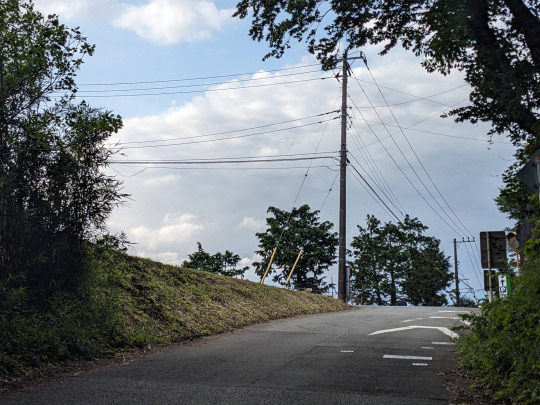
施錠30分前に駐車場についた。学生が一人、吹奏楽の練習をしていた。 混んでないはずなのになぜ私の車の横に車が止まっているのか、気にはなったがタイヤの下の空になった日焼け止めを回収して、靴を履き替え、服を着替え、ドライブスルーができる店を手早く探し、車に乗って帰った。
2025-06-01
2 notes
·
View notes
Text
🔞 夜間密會:與秦徹的祕密之夜 | 無遮掩 18+ 成人音頻 | 戀與深空
他冷靜克制,但今夜只屬於你。 門一關上,吻如烈火,佔有欲洶湧。 是喘息,是親吻,是肌膚碰撞的聲音—— 秦徹低語著你的名字,不再壓抑,只想要你。
🎧 建議戴耳機沉浸收聽 🔞 主導 x 無遮掩 x 火熱 💦 今晚,你就是他的唯一渴望
🔞 Nightly Rendezvous: Night of Secrecy w/ Sylus | Uncensored NSFW Audio (18+) | CN Dub + EN Version Available💦 Now available in CN Dub with an English version uploaded too!
#lads#sylus x mc#sylus smut#l&ds sylus#lnds sylus#love and deepspace sylus#lads sylus#qin che#sylusposting#sylus lads#sylus#dragon sylus#lads mc#love and deepspace#asmr sounds#asmr#boyfriend asmr#asmr roleplay
23 notes
·
View notes
Quote
家庭教育支援法の制定を求める意見書提出に関する陳情 家庭教育を推進する神奈川県民の会 近藤正栄 武者宗悦 川崎 小田原 秦野 綾瀬 藤沢 座間 伊勢原 茅ヶ崎 逗子 厚木 山北 葉山 愛川 二宮 大磯 清川 可決川崎 藤沢 厚木
[B! 自民党] 「統一教会、辞めてますよ」報道陣シャットアウトの出陣式で、鈴木エイト氏が聞き出した衝撃の発言《山際大志郎氏の秘書問題》 | 文春オンライン
2 notes
·
View notes
Text
Modern The First Emperor of Qin: Xi Jinping (Essay)
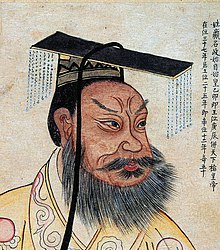
The First Emperor of Qin
``Even if there is someone who has a different opinion than yours, do not deny the other person's position, but rather engage in dialogue and seek a compromise. “Law'' regulates these actions and attempts to reconcile interests. This is the essence of democracy. However, some cannot understand this logic at all...China's President: Xi Jinping.
He suppresses opinions that differ from his own. This is using the "laws" he arbitrarily enacted. It is a ``law'' for oppression, not a ``law'' for adjusting interests. Hong Kong is an easy-to-understand example. In addition to sufficiently depriving Hong Kong citizens of their freedoms under the Hong Kong National Security Law, the law "legally" deprived pro-democracy candidates of the opportunity to run in district council elections. In the end, no one could run. and he excluded democratic factions from the district assembly. What a wonderful application of the "law"!
Repression by ``law''... Xi Jinping is said to respect the ancient Chinese thinker: Han Fei. Han Fei envisioned applying ruthless ``laws'' to the common people to suppress them. Of course, there was no dialogue, it was a one-way street. The First Emperor of Qin was the one who adopted this idea, so isn't Xi Jinping aiming to become The First Emperor? He hangs a picture of the Great Wall of China built by The First Emperor. He believes in political ideas from 2000 years ago. It's anachronistic and frightening. Maybe Xi Jinping is an extremely timid person. Because he is afraid of dialogue. Does Xi Jinping know that The First Emperor wanted to become a god and drank mercury as a means to that end? What if Xi Jinping also drank mercury? As a fake chemist.
Rei Morishita
現代の始皇帝:習近平(エッセイ)
「自分と異なる意見の者がいたとしても、相手の立場は否定せず、対話し妥協点を探る。それらの行動を規定し、利害調整を図るのが「法」である。これは民主主義の要諦である。しかし、この理屈を全く理解できない者がいる・・・中国国家主席:習近平である。
彼は自分と異なる意見を、圧殺する。彼が恣意的に制定した「法」によってである。抑圧するための「法」であり、利害調節のための「法」ではない。解りやすい事例として香���がある。香港国家安全維持法によって香港市民の自由を十分奪っているのに加え、区議会議員選挙で、民主派の候補の立候補の機会を、「法」によって「合法的に奪い」、ついにはだれも立候補できなくし、民主派を区議会から締め出した。なんて見事な「法」の適用だろう。
「法」による抑圧・・・習近平は古代中国の思想家:韓非を尊敬しているという。韓非は非情な「法」を庶民に適用して抑圧することを構想した。もちろん対話などなく、一方通行だ。この思想を採用したのが秦の始皇帝であり、習近平は始皇帝を目指しているのではないか。彼は、始皇帝の作った万里の長城の絵を掛けている。彼は2000年前の政治思想を信奉している。アナクロであり、恐ろしいことである。たぶん、習近平は小心者である。対話が怖いのだから。始皇帝は神になることを望み、その手段として水銀を飲んでいたことを習近平は知っているだろうか?習近平も水銀を飲んだらどうだろう?化学者もどきとして。
#The First Emperor of Qin#Xi Jinping#essay#rei morishita#Law#Hong Kong#Hong Kong National Security Law#Han Fei#Great Wall#afraid of dialogue#mercury#fake chemist
11 notes
·
View notes